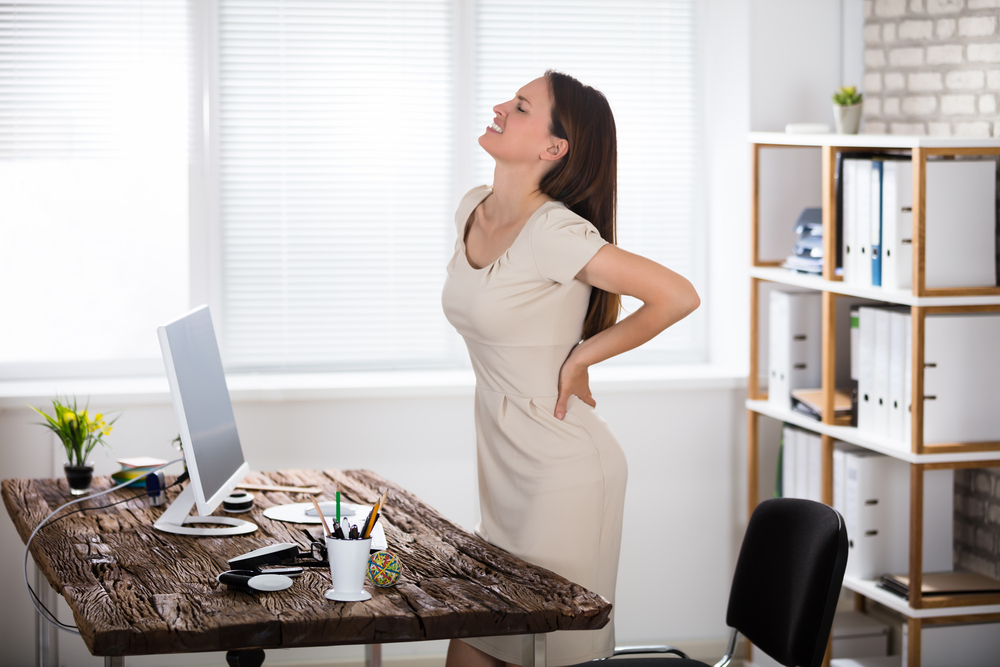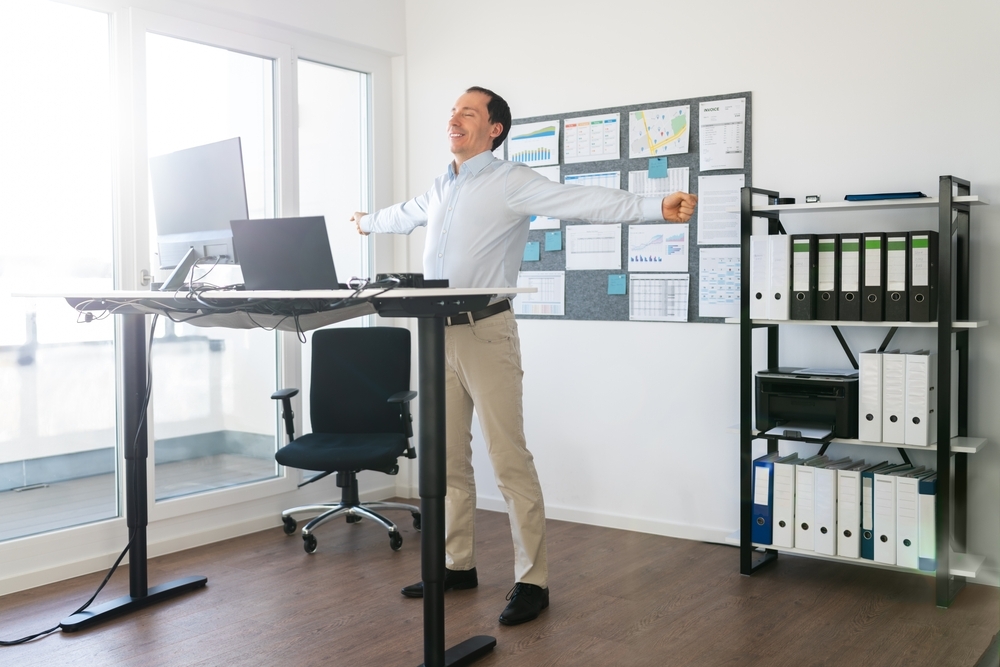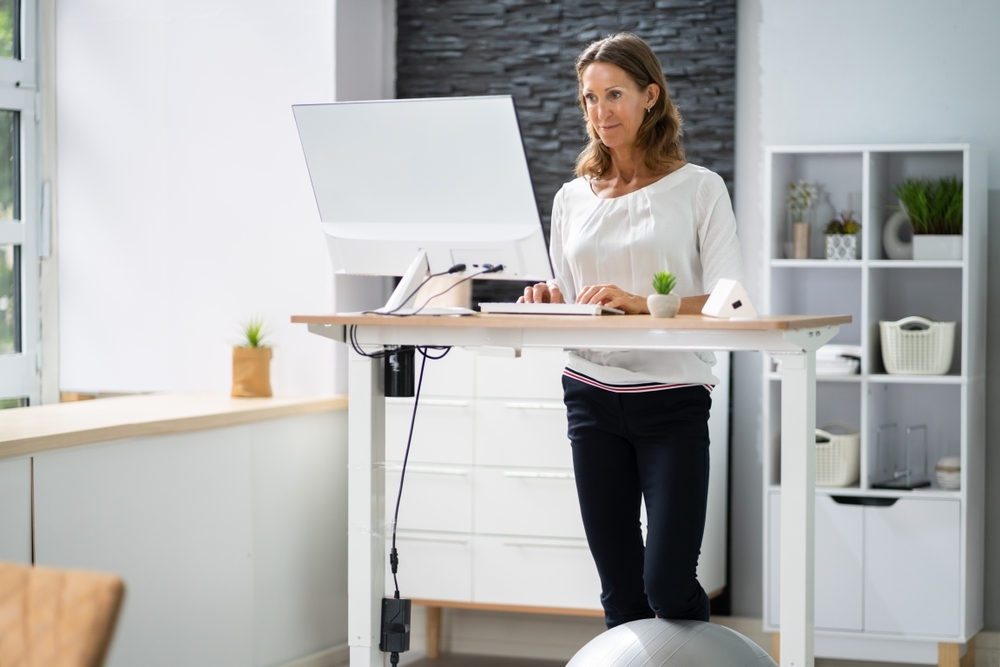Your back is sore, achy, and screaming at you during work – a familiar scenario in the age of 9 to 5 desk jobs. While technology continues advancing, our bodies remain adapted to the nomadic hunter-gatherers of yesterday. Yet natural movement once inherent to survival now seems a luxury afforded only outside work hours thanks to the seated chains of computer screens and keyboards.
This stark disconnect translates into an epidemic of back pain as modern conveniences collide with our physiology. According to the Canadian Pain Society, over 60% of Canadian adults report experiencing back pain each year. Medications and surgeries fail to target the root problem: sustained postural strain from chronic sitting compressing delicate joints hour after hour.
But what if your workstation could literally lift you up while also decompressing away this pain? Enter the height-adjustable standing desk – your ticket to mixing relieved postures tailored to your body’s needs. With the touch of a button, these ingenious platforms can transition seamlessly from comfortable chair level to upright relief taking all weight off the spine whenever you please.
Intrigued how this simple concept can alleviate even stubborn back pain? Read on to learn all about using sit-stand desks to positively transform your office experience and gain insights from ergonomics experts on optimizing posture concepts that best support long-term healing.
Understanding Lower Back Pain
Lower back pain affects over 6 million Canadian adults annually and ranks as the leading cause of disability worldwide. Spinal experts correlate this modern epidemic directly with stagnant seated postures inherent to office work.
Sustained sitting literally strains the intricate muscles enveloping each vertebrae plus discs cushioning between them hour after hour. Over time, this constant compression and restricted blood flow causes inflammation, degeneration, and those nagging symptoms radiating around the hips and thighs.
To assess whether your current lower back discomfort relates to ongoing postural strain versus underlying injury, consider these questions:
- Does pain start during lengthy desk work sessions but seem alleviated once moving?
- Is pain focused across low back and coccyx without specific trauma or injury?
- Do you notice posture slumping more as workdays wear on?
If answering yes, you likely suffer from what doctors term “mechanical back pain”. The good news? This variety responds exceptionally well to postural improvements via standing desks and ergonomic equipment. Back health now rests firmly within your control.
Let’s explore using sit-stand stations to nip lower back pain from the root source: sustained sitting itself. Simple equipment and postural upgrades yield major quality-of-life wins.
The Traditional Office Setup and Its Drawbacks
The classic office landscape filled with rigid desks and cushy chairs seems innocuous enough. Yet this stationary scene fuels a painful disconnect between human physiology and modern work life. Our bodies thrive on movement – transitioning fluidly between various postures and dynamic tasks as needed. Compare this to the average desk worker glued in place for 80% of their waking hours!
Fixed seated workstations force the spine into sustained flexion barely alternating positions across lengthy periods. Slouching posture sinks the head forward and strains the intricate muscles wrapping each vertebrae. Discs have no reprieve from unrelenting compression. Meanwhile, our active muscles grow overworked while unused groups completely atrophy from disuse on the chair.
This total lack of position variation starves tissues of vital circulation and bears direct consequences. Inflammation simmering in strained low back structures quickly boils over into painful spasms and repetitive stress injuries. Nerves serving the hips and legs get irritated causing symptoms radiating down the limbs. Over the years the very discs padding our vertebrae wear away from constant load in the same exact manner.
Without sufficient movement or postural balance, the traditional office fuels pain and degeneration regardless of ergonomic cushions or lumbar supports. Tissues need nutrition, alternation, and decompression to optimize health. Prolonged sitting deprives them of all three.
Introduction to Sit-Stand Desks
Sit-stand desks offer the best of both worlds – alternating between sitting and standing postures on demand. These height-adjustable workstations allow users to manually or automatically raise and lower the work surface in mere seconds. This empowers smoothly transitioning between using the desk from a seated position or while standing upright.
Unlike traditional rigid desks confined to just one fixed height and posture, sit-stands introduce active variability within office work itself. They often utilize electric motors to effortlessly customize height accommodating chairs or standing ergonomics as needed. Others feature smooth crank systems for easy manual adjustments on the fly. This constant interplay between postures nurtures the structures strained under sustained sitting, restoring balance to the workday.
While early standing desks existed decades ago, the modern digital era’s health impacts sparked surging interest in sit-stand desk solutions. With back pain and obesity rates skyrocketing in parallel with tech adoption, researchers correlated prolonged inactivity as the dominant risk factor. Major companies like Apple and Google pioneered integrating standing desks to get employees moving again.
Continual advancement of their affordable components plus rising safety awareness makes owning one easier than ever. Introducing this simple equipment can alleviate stubborn back pain stemming from our high-tech lifestyles.
How Sit-Stand Desks Help
The magic of sit-stand desks lies in their fluid versatility, empowering movement that was once missing while doing digital work. Alternating postures properly nourishes the intricate structures starving within sustained sitting’s static confinement. Think of flexing the back just as crucial for spinal health as flexing stiff fingers after hours of typing stationary.
Regularly standing up effectively decompresses the entire back while pumping nutrients in. Our intervertebral discs soak up fluid relieving squashed cushioning between vertebrae. Compressed nerves relax. Back muscles stretch and strengthen from new posture demands after relaxing face-down at the desk.
Like a compressed sponge expanding with water, the spine unravels from top to bottom with each standing break. Simply leaving the vulnerable hunched position trains muscles to uphold healthier alignment. Just this basic intermittent mobility gently restores and maintains the back’s stabilizing system often severely weakened while seated.
“Introducing alternating upright postures re-engages essential back muscles that grow dormant when sitting for long periods. This effectively decompresses facet joints plus discs that commonly flare up with inflammation,” explains Vancouver physiotherapist Dr. Adam Holt. “Height adjustable desks facilitate this variability seamlessly across long workdays.”
The key lies in moderation – avoiding overworking either sitting or standing alone. Listen to signals from strained areas and alternate position the moment any discomfort arises. Consistently transition before pain every 20-30 minutes and witness the body incrementally strengthen.
Making the Most of Your Sit-Stand Desk
Reaping all the back-saving benefits from a height-adjustable desk depends greatly on proper use. Optimizing both sitting and standing ergonomics ensures each posture nourishes the spine versus straining it. Complementary movements further boost benefits by enhancing circulation and strengthening stabilizers. Follow these best practices:
When sitting, adjust the desk height for elbows at 90 degrees and your vision level with the monitor. Maintain upright posture avoiding slouching forwards. Every 20-30 minutes stand to briefly retract the shoulders, straighten the spine, and take a few deep breaths.
For standing, raise the desk surface to around 50 inches or allowing wrists relaxed at your sides. Use supportive shoes and cushy anti-fatigue mats. Start with conservative standing stretches of 20-30 minutes building up gradually as muscles adapt. Every half hour of standing, take a seated break to restore blood flow.
Beyond static standing, engage free weights for gentle bicep curls opening the chest plus trunk rotations mobilizing the mid and upper back. Practice mini-squats focusing on proper knee alignment to gently strengthen legs. Simple spinal twists wring tension from lower back facets. Just avoid over-arching and remain pain-free.
Pair sit-stand routines with regular walking breaks plus dedicated mobility sessions to assist proper muscle retraining. But most importantly listen to your body and adjust the desk whenever strains announce themselves. Correct personalized posture and dosing maximizes gains.
Choosing the Right Sit-Stand Desk
With so many options now available, selecting the ideal adjustable desk tailored to your needs and budget takes some consideration. Seek out height ranges accommodating both sitting and standing postures for true flexibility. Consider controls facilitating seamless position changes – think effortless one-touch buttons.
Seeking out quality components also ensures smooth adjustments and desk longevity through years of daily modulation. Look for stability from strong base frameworks plus lifting capacities suiting your workspace needs. And don’t neglect surface space allowing proper ergonomic equipment arrangement in both sit and stand arrangements.
Begin by determining the right base type – manual crank or electric motor-driven. Manual cranks offer cost savings yet require more effort adjusting. Electric desks smoothly transition to any customized height and recall favorite presets at the push of a button. Solo motors get the job done on a budget while dual/triple motor desks raise both sides synchronously for perfectly parallel surfaces.
Those needing compact solutions benefit from converter products transforming existing desks into height adjustable stations. Specialized stand up desks provide ample room for scaffolds holding multiple monitors critical for intensive data analysis. Considering your space, equipment needs and mobility goals shapes the optimum adjustable solution.
Companies like Hiilo thoroughly vet sitting and standing desk options across all budgets to simplify selection. Their wide array of manual, electric, and specialty table finds the perfect fit for wellness goals and work style. Safety features plus durable build quality ensure years of healthy movement supporting your most productive hours.
Here is a draft section addressing common concerns and misconceptions about sit-stand desks:
Addressing Common Concerns and Misconceptions
When considering integrating sit-stand technology, some valid questions arise on ideal usage plus perceived drawbacks. Here are a few questions and answers on maximizing benefits from your adjustable investment:
Do sit-stand desks negatively impact productivity?
On the contrary – studies demonstrate standing desks boost energy, engagement and workload accuracy. Just make sure to implement proper posture practices plus take movement breaks to stay refreshed.
Aren’t sit-stand desks expensive investments?
Prices continue to drop thanks to widespread adoption and component improvement. And considering the cost savings from avoiding back pain treatments, their health dividends far outweigh initial investments.
I already have a suitable desk. Now what?
No problem! Converter products transform your existing desk into a height adjustable station for the best of both worlds. Retain your preferred work surface while adding movement.
How difficult is assembly/installation?
Most quality electric desk brands now ship with simple 5 minute attachment steps for tabletops needing only a screwdriver. Manual crank options arrive fully preassembled out the box!
Without chairs aren’t standing desks uncomfortable?
Supportive anti-fatigue mats absorb impact alongside shoes with ample cushioning. Just remember to alternate sit/stand postures every 20-30 minutes until building greater standing stamina.
Still have concerns unanswered? Reach out to our team for tailored product guidance maximizing wellness benefits unique to your needs.
Lift Yourself to Better Back Health
The modern office no longer needs trapping workers in painful stationary postures all day long. With sit-stand desks now more affordable and accessible than ever before, introducing variability into previously sedentary routines brings profound rewards. Simply alternating between sitting and standing postures properly decompresses the strained spinal structures triggering most mechanical back pain.
Consistency remains key – avoid sustained positions for longer than 20-30 minutes before changing it up. Gradually increase standing durations in tandem with supportive equipment like cushioned mats. Begin witnessing pain dissipate as compressed tissues rehydrate and nerves relax through gentle movement squirted back into lifeless work days.
Whether back discomfort runs chronic or just occasional, a small investment towards better posture yields invaluable and lasting quality of life upgrades. Ditch the stagnancy sinking you deeper into pain’s grip. Instead, lift yourself seamlessly towards refreshed joints, stronger muscles and lasting alignment gains with the touch of button.
Ready to elevate your office today? Discover Hiilo’s range of height adjustable options built for fluid functionality and enduring performance. Their smooth manual cranks to pre-programmable electric models unlock personalized back relief meeting all needs and budgets. Don’t settle for the sit status-quo a moment longer – you deserve a workspace aligned with movement today!





The 2us2 11 hiilo.com 8e
Bula dinor 000x hiilo.com 0r
Doplo kilot *111 hiilo.com WC
Doplo kilot *111 hiilo.com Vp
Bekil kupil *982 hiilo.com pI
Doplo kilot *111 hiilo.com HJ
Bekil kupil *982 hiilo.com SN
Doplo kilot *111 hiilo.com ih
Doplo kilot *111 hiilo.com FH